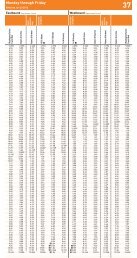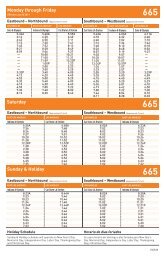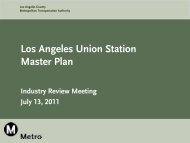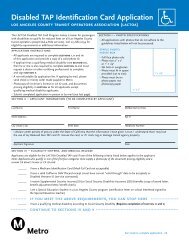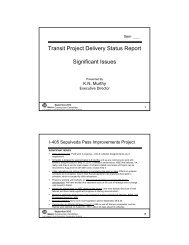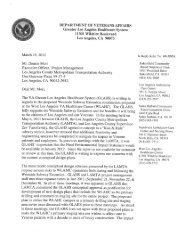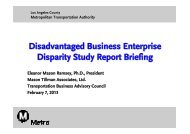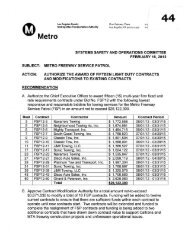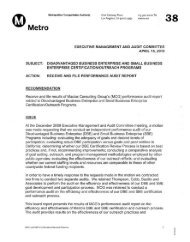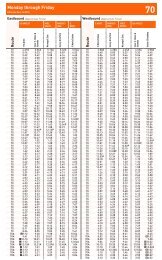Sepulveda Pass Corridor Board Report - Metropolitan ...
Sepulveda Pass Corridor Board Report - Metropolitan ...
Sepulveda Pass Corridor Board Report - Metropolitan ...
Create successful ePaper yourself
Turn your PDF publications into a flip-book with our unique Google optimized e-Paper software.
<strong>Sepulveda</strong> <strong>Pass</strong> <strong>Corridor</strong> Systems Planning Study Executive Summary<br />
The major engineering issues and cost factors<br />
identified for each systems concept and the<br />
high-level capital cost derived from application<br />
of the unit cost for these elements appear<br />
below.<br />
• Concept 1: Shoulder Running BRT<br />
Full <strong>Corridor</strong> (30 miles) $162 million<br />
<strong>Sepulveda</strong> <strong>Pass</strong> (10 miles) $146 million<br />
This concept would restripe approximately<br />
8.5 miles of the I-405 Freeway to allow<br />
shoulder running buses during peak<br />
periods. The concept assumes a fleet of<br />
higher performance buses to handle the<br />
steep grades in the <strong>Sepulveda</strong> <strong>Pass</strong>. The<br />
full project length would extend from<br />
Sylmar/San Fernando Metrolink Station in<br />
the northern San Fernando Valley to the<br />
LAX Transit Center over a distance of 30<br />
miles. An initial project length was<br />
estimated to run from the Metro Orange<br />
Line <strong>Sepulveda</strong> Station to the Metro Expo<br />
Line Station over a distance of 12 miles.<br />
• Concept 2: At-Grade Managed Lanes with<br />
BRT<br />
Full <strong>Corridor</strong> – (28 miles) $1.7 billion<br />
<strong>Sepulveda</strong> <strong>Pass</strong> – (10 miles) $1.1 billion<br />
This concept would restripe the I-405<br />
Freeway to provide 4 managed lanes<br />
between the US 101 (Ventura) Freeway and<br />
just north of the I-10 Freeway over a<br />
distance of approximately nine miles.<br />
Direct access ramps would be provided at<br />
the Metro Orange Line near Victory<br />
Boulevard and between Santa Monica and<br />
Olympic Boulevards on the Westside.<br />
North and south of the 4-lane managed<br />
lane segment, the 2 HOV lanes in each<br />
direction would be converted to a 2-lane<br />
managed lane segment. The full project<br />
length would extend from the I-5/I-405<br />
Interchange in the northern San Fernando<br />
Valley to the LAX Transit Center and the I-<br />
105 (Century) Freeway over a distance of<br />
30 miles.<br />
An initial project length was estimated to<br />
run from the Metro Orange Line <strong>Sepulveda</strong><br />
Station to the Metro Expo Line Station over<br />
a distance of 12 miles. Transit buses<br />
would gain access to the facility via the<br />
above direct access connectors from local<br />
streets in the San Fernando Valley and the<br />
Westside, but express buses could travel<br />
for all or portions of the full corridor.<br />
• Concept 3: Aerial/Viaduct Managed Lanes<br />
with BRT<br />
Full <strong>Corridor</strong> – (30 miles) $2.3 billion<br />
<strong>Sepulveda</strong> <strong>Pass</strong> – (10 miles) $1.4 billion<br />
The highway viaduct considered for this<br />
concept would be configured above the<br />
median of the I-405 Freeway between the<br />
US 101 and the I-10 Freeway. The aerial<br />
viaduct would consist of four managed<br />
lanes (two in each direction) and would be<br />
constructed in the median area. The<br />
structure was conceived as being<br />
supported by 10 foot wide center running<br />
columns, utilizing the inside shoulder area<br />
from the north and south bound<br />
directions.<br />
Access to the highway viaduct would be at<br />
three locations, north of the US 101 at<br />
Burbank Boulevard, at US 101 and a<br />
southern access point between Santa<br />
Monica and Olympic Boulevards. North<br />
and south of the viaduct section, the<br />
existing, surface running HOV lanes would<br />
be retained and could be converted to<br />
managed lanes in their current<br />
configuration of one lane in each direction.<br />
<strong>Sepulveda</strong> <strong>Pass</strong> <strong>Corridor</strong> Systems Planning Study Page ES -25<br />
Executive Summary



